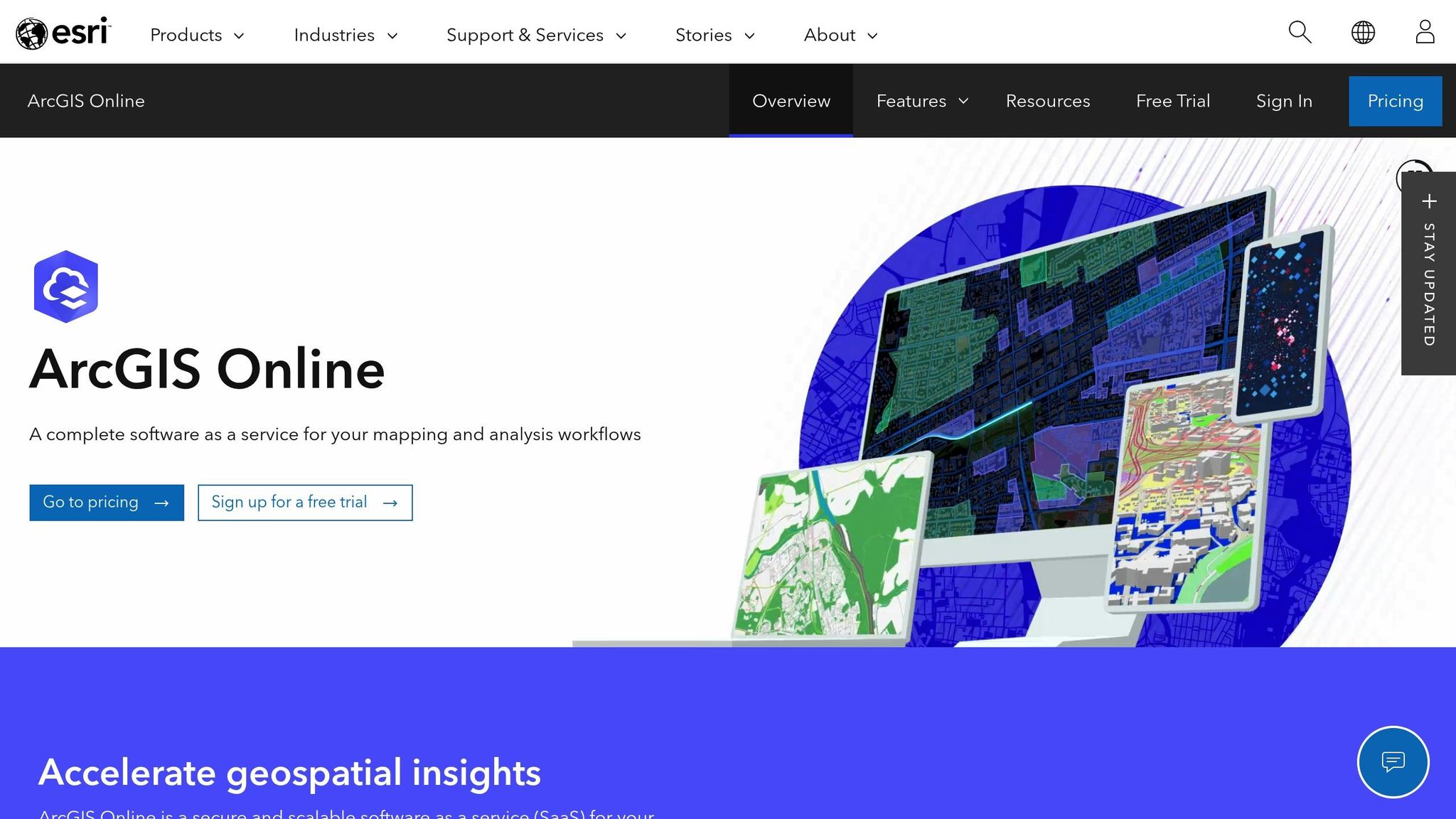Automated Valuation Models (AVMs) are reshaping property valuation by using algorithms to estimate property values quickly. However, they often miss critical location-based factors. Enter geospatial analysis, which adds layers of geographic insights – like proximity to schools, transportation, and risk zones – to refine valuations.
Key Takeaways:
- AVMs analyze property features and sales data to deliver fast valuations, but lack depth in location-specific insights.
- Geospatial analysis incorporates data like neighborhood characteristics, environmental risks, and access to amenities.
- Tools like Geographic Information Systems (GIS) process spatial data, improving accuracy by accounting for spatial relationships like proximity and clustering effects.
- Combining AVMs with geospatial data results in more precise property valuations and deeper market insights.
While geospatially-enhanced AVMs improve accuracy, challenges like data quality, computational demands, and regional variations require attention. For real estate professionals, integrating geospatial tools offers a better way to understand how location impacts property value.
Valuation Workflows Within ArcGIS

Key Components of Geospatial Analysis in AVMs
Breaking down the essentials of geospatial analysis sheds light on why incorporating these tools into automated valuation models (AVMs) can lead to more accurate property valuations. Each element contributes insights that traditional models often miss.
Types of Geospatial Data for AVMs
Geospatial data used in property valuation can be grouped into several key categories:
- Property location data: This includes exact coordinates, parcel boundaries, and lot layouts. These details help AVMs accurately position a property within its neighborhood, a crucial factor in determining its value.
- Neighborhood characteristics: Data like demographics, crime rates, walkability scores, and access to local amenities all play a role in shaping a property’s appeal. For instance, homes near well-regarded schools or in low-crime areas often command higher prices.
- Transportation access: Information about proximity to highways, public transit, airports, and major job hubs is critical. Commute times and traffic patterns significantly affect a property’s desirability.
- Environmental and risk factors: This includes data on flood zones, earthquake fault lines, wildfire risks, and pollution sources. Properties in high-risk areas tend to see lower values, while those in safer locations may enjoy a boost.
- Infrastructure and development data: Utilities, planned construction projects, zoning changes, and municipal services are all factors that can influence property values. New infrastructure can increase appeal, while certain developments might have the opposite effect.
- Economic indicators: Local employment rates, income levels, and business activity provide context on an area’s economic vitality, which directly impacts property demand.
Next, Geographic Information Systems (GIS) come into play, turning this raw data into actionable insights.
Using Geographic Information Systems (GIS) for Data Analysis
Once geospatial data is collected, GIS tools are essential for making sense of it. These systems transform layers of data into meaningful insights that AVMs can use to refine property valuations.
- Data visualization: Tools like heat maps and overlay analyses highlight trends that might not be obvious from raw data. For example, buffer zones around schools or parks can reveal hidden value drivers.
- Spatial analysis functions: These tools measure distances, calculate areas, and analyze relationships between features. For instance, GIS can evaluate how property values change with proximity to transit hubs, considering actual travel routes instead of simple straight-line distances.
- Buffer analysis: This method defines zones around specific features, such as high-rated schools, to identify areas where properties might benefit from a valuation premium.
- Network analysis: By examining road networks, GIS can assess realistic travel times and connectivity, offering a more accurate picture of a property’s accessibility.
- Temporal analysis: Tracking changes over time, GIS can study how new developments or shifting demographics influence property values gradually.
When GIS is paired with machine learning, AVMs become even more dynamic, adapting to new data and reflecting market changes in real time.
How Spatial Relationships Affect Property Values
GIS analysis goes a step further by uncovering the spatial relationships that influence property values. These relationships capture the interplay between properties and their surroundings, revealing patterns that traditional AVMs might miss.
- Proximity effects: Being close to desirable amenities like parks, reputable schools, or shopping centers typically boosts value, while proximity to less appealing features can lower it. These effects often diminish with distance.
- Clustering effects: When similar properties or amenities are grouped together, they can amplify each other’s value. For example, a cluster of high-end restaurants can elevate nearby property prices more than a single establishment would.
- Spillover effects: Improvements or developments in one area can raise property values in neighboring zones. Projects like urban renewal or new transit stations often have a ripple effect.
- Boundary effects: Administrative or natural boundaries – such as school district lines, city borders, or rivers – can create stark contrasts in property values, even for homes with similar characteristics.
- Accessibility patterns: Properties with strong connections to employment hubs, services, and amenities through transportation networks often see higher demand and value.
- Market segmentation: Geographic factors can create distinct submarkets within a region. Waterfront homes, hillside properties, or historic districts often follow unique valuation patterns that require specialized analysis.
These spatial dynamics explain why some properties command "location premiums" while others face "location discounts." By leveraging geospatial analysis, AVMs can better capture these nuances, resulting in valuations that more accurately reflect how location influences property worth.
How to Add Geospatial Analysis to AVMs
Integrating geospatial analysis into Automated Valuation Models (AVMs) involves turning raw geographic data into meaningful insights that enhance property valuations. Here’s how to do it effectively.
Collecting and Enriching Geospatial Data
The first step is gathering detailed geographic data that goes beyond basic property records. This includes tapping into resources like the U.S. Census for demographic information, FEMA for flood risk data, and local tax assessor records for property specifics. To build a comprehensive dataset, incorporate additional layers such as transportation networks, environmental factors, school district data, and local law enforcement statistics.
Once collected, the data must be enriched to provide deeper context. For example, property records can be enhanced with geocoding and overlays that highlight proximity to transit, flood zones, or high-quality schools. This process creates a more detailed profile of each property, offering insights into local risks and amenities.
Ensuring the accuracy of this data is critical. Techniques like address standardization, coordinate validation, and regular updates help maintain reliability. Tools like BatchData simplify this process by offering pre-enriched datasets with geographic and property details, accessible through user-friendly APIs. With enriched data in place, the next step is incorporating spatial variables into the AVM.
Adding Spatial Variables to AVMs
To refine valuations, integrate spatial variables that reflect a property’s geographic context. These variables might include proximity to transit, employment hubs, amenities, and local socioeconomic factors. The key is identifying which geographic elements matter most in a given market.
For example, neighborhood characteristics – such as income levels, crime rates, and walkability – can provide a snapshot of the local environment. Buffer analysis helps define the geographic range of these influences.
Risk assessment is another crucial factor. Properties in flood zones or near environmental hazards often see valuation impacts. Similarly, market segmentation variables can identify unique submarkets, like waterfront properties or historic districts, that may follow distinct pricing trends.
Transforming raw data into usable metrics is essential. For instance, combining a property’s distance from schools with education quality ratings can create a comprehensive index that reflects its appeal to families.
Applying and Refining Geospatial Models
Once spatial variables are in place, refine the AVM using advanced techniques to account for local variations. Traditional regression models can be enhanced with methods like Geographically Weighted Regression (GWR), which captures location-specific trends. Spatial autocorrelation analysis can identify clusters of similar properties and pinpoint outliers that deviate from neighborhood norms.
Model validation is a continuous process. Cross-validation and error analysis ensure accuracy, while iterative refinements help the model adapt to changing geographic conditions. Tracking performance metrics like error rates and biases keeps the AVM reliable across different areas.
To further improve accuracy, consider using ensemble methods. By combining multiple geospatial models, each focusing on different valuation factors, you can minimize the weaknesses of individual models and produce more reliable results.
This comprehensive approach allows AVMs to better reflect the intricate relationship between location and property value, delivering more precise valuations for investors and real estate professionals alike.
Benefits and Challenges of Geospatially-Enhanced AVMs
Geospatially-enhanced AVMs (Automated Valuation Models) offer a range of advantages, but they also come with unique challenges. Let’s break down the key points.
Benefits of Geospatial Analysis in AVMs
Improved Valuation Accuracy is one of the standout advantages. By factoring in elements like proximity to amenities, neighborhood qualities, and exposure to environmental risks, these models can better reflect the true value of a property. Two homes may appear identical on paper but differ significantly in value depending on their location. Geospatially-enhanced AVMs are designed to capture these distinctions.
Deeper Market Insights become achievable when spatial data is included. These models can identify subtle market differences within small geographic areas. For example, a property near a transit hub might command a premium, while one just a few blocks away in a flood-prone zone could see a reduced valuation. This level of detail helps stakeholders – like investors and lenders – make more informed decisions.
Enhanced Risk Analysis is another key benefit. By integrating data such as FEMA flood zones, crime statistics, and other location-based risks, these AVMs can provide a more comprehensive picture of the factors that may impact a property’s value over time.
Scalability with Geographic Intelligence is maintained despite the added complexity. Once spatial data is integrated, these models can deliver automated valuations for large property portfolios. This makes them especially useful for organizations that need to assess hundreds or even thousands of properties quickly.
Challenges and Limitations
Data Quality and Consistency can be a significant hurdle. Geographic data often varies in terms of accuracy, how frequently it’s updated, and its coverage. For instance, census data may be outdated, and crime statistics can differ in reliability depending on the reporting jurisdiction. These inconsistencies can lead to errors in the valuation process.
Increased Model Complexity and Computational Demands are another challenge. Adding spatial variables means processing geographic relationships, calculating distances, and analyzing spatial patterns – all of which require more advanced algorithms and greater computational power. This can slow down processing times and increase costs for infrastructure.
Specialized Expertise is essential but not always easy to find. Professionals working on these models need to be skilled in both real estate valuation and geographic information systems (GIS). Finding data scientists with this dual expertise can be time-consuming and expensive.
Regional Variations in Market Drivers present another challenge. Factors influencing property values in a dense urban area like Manhattan differ dramatically from those in rural regions such as Montana. Models must be carefully calibrated to account for these differences, which requires ongoing adjustments.
Regulatory and Privacy Concerns add further complexity. Some geographic data sources come with usage restrictions, and privacy laws may limit how demographic or socioeconomic data can be used. Balancing these constraints with the need for accurate valuations is an ongoing challenge.
Feature Comparison: Standard vs. Geospatially-Enhanced AVMs
Here’s a quick comparison of how standard AVMs stack up against their geospatially-enhanced counterparts:
| Feature | Standard AVMs | Geospatially-Enhanced AVMs |
|---|---|---|
| Data Sources | Property records, sales history, basic demographics | Adds spatial data, environmental factors, and proximity metrics |
| Valuation Accuracy | Suitable for homogeneous areas | Higher accuracy across diverse locations |
| Risk Assessment | Limited to property-specific risks | Includes environmental, social, and infrastructure risks |
| Model Complexity | Moderate computational needs | Requires advanced spatial processing capabilities |
| Implementation Time | 2-4 weeks | 6-12 weeks with spatial data integration |
| Expertise Required | Real estate analysts, data scientists | GIS specialists and spatial data experts in addition to analysts |
| Cost Structure | Lower setup and maintenance costs | Higher costs, including spatial data licensing fees |
| Market Adaptability | Limited geographic awareness | Adjusts dynamically to local conditions |
| Scalability | Works with standard infrastructure | Needs specialized infrastructure for spatial processing |
Geospatially-enhanced AVMs clearly bring a wealth of benefits, but they also require more resources, expertise, and infrastructure to fully realize their potential. While the trade-offs are significant, the added precision and insights they offer can make them invaluable for organizations operating in complex and varied real estate markets.
sbb-itb-8058745
Best Practices for Adding Geospatial Analysis to AVMs
Accurate geospatial data is essential for improving Automated Valuation Models (AVMs). By following these best practices, you can integrate geospatial analysis effectively and boost model precision. Focus on maintaining data quality, leveraging advanced modeling techniques, and using professional data services to ensure compliance and scalability.
Ensuring Data Quality and Completeness
High-quality data is the backbone of any geospatial AVM. Regulatory bodies like the Office of the Comptroller of the Currency (OCC) require institutions to implement strong policies and controls to ensure reliable estimates and safeguard against data manipulation. This means your geospatial data must meet strict standards for accuracy, relevance, and timeliness.
To maintain data integrity, include detailed metadata with every geospatial dataset. This metadata should outline the dataset’s source, quality attributes, collection methods, and update frequency. Proper documentation enables your team to understand the dataset’s limitations and use it appropriately, minimizing costly valuation errors.
Visual validation tools like maps and charts can help identify errors, outliers, or inconsistencies. For instance, mapping property points may reveal anomalies, such as properties located in incorrect areas, which could indicate data inaccuracies.
Regular data audits are also crucial. As census data, zoning laws, and infrastructure evolve, updating your datasets ensures they remain current and reliable. With a solid data foundation, you can scale your AVM more efficiently using professional data services.
Using Advanced Modeling Techniques
Advanced modeling techniques can uncover location-specific insights that traditional models often overlook. For example, spatial regression methods like Geographically Weighted Regression (GWR) can capture patterns tied to specific locations, accounting for how nearby properties influence each other’s values.
Ensemble modeling is another effective approach. By combining multiple spatial algorithms, you can offset the weaknesses of individual models and deliver more dependable valuations across various geographic regions.
Machine learning algorithms designed for spatial data, such as spatial random forests or kriging methods, are also valuable tools. These methods can handle complex geographic relationships and automatically adjust to local market conditions, enhancing the accuracy of your AVM.
Using Professional Data Services for Scalability
Professional data services can simplify the management and enrichment of geospatial data. Platforms like BatchData consolidate multiple real estate data sources into a single, reliable stream, making processes like data standardization and quality control more efficient.
Adding location-based attributes – such as walkability scores, school ratings, or environmental risk factors – further enriches your property records. These additional details provide deeper spatial context, leading to more defensible valuations and ensuring compliance with regulatory standards.
Many data service providers also offer built-in validation and compliance tools to meet industry requirements for accuracy and model governance. This allows your team to focus on developing and refining the AVM while maintaining high standards for data quality and regulatory adherence.
Conclusion: The Future of Geospatial Analysis in AVMs
Geospatial analysis is transforming how property valuations are conducted. With AI-powered geospatial analysis (GeoAI), professionals can now process massive spatial datasets with greater accuracy and speed. By combining Geographic Information Systems (GIS) and artificial intelligence, GeoAI supports predictive analytics for market trends and automates the extraction of features from imagery. The global GeoAI market is expected to grow significantly, reaching $64.60 billion by 2030, with an annual growth rate of 9.25%. Beyond AI, advancements in sensors and connectivity are further refining these valuation models.
The integration of Internet of Things (IoT) devices with geospatial systems is another game-changer. By continuously monitoring property conditions, neighborhood developments, and market dynamics, IoT devices enable real-time data collection. Combined with edge computing, this approach processes data closer to its source, reducing delays and enhancing the responsiveness of valuation models – especially for smart city applications.
Emerging technologies like 3D GIS and digital twins are also reshaping property assessments. These tools simulate real-world environments, offering powerful applications in urban planning and development. Digital twins, created using 3D spatial data, allow professionals to model potential changes and predict their impact on property values before they happen.
Cloud-based GIS solutions are making advanced geospatial tools more accessible. They provide scalability, improve collaboration among teams, and reduce costs, which were once barriers for smaller organizations. Additionally, the rise of location intelligence is pushing the boundaries of what geospatially enhanced Automated Valuation Models (AVMs) can achieve, leading to more precise and defensible property valuations.
To stay competitive, real estate professionals must embrace these advancements. Firms that integrate cutting-edge geospatial analysis into their AVMs today will be better positioned to meet future challenges. By leveraging tools like BatchData (https://batchdata.io), which enhance data integration and enrichment, professionals can build a solid foundation for their AVMs, ensuring more accurate valuations and meeting the evolving expectations of clients and regulators.
FAQs
How does geospatial analysis make Automated Valuation Models (AVMs) more accurate in real estate?
How Geospatial Analysis Enhances AVMs
Geospatial analysis takes Automated Valuation Models (AVMs) to the next level by weaving in detailed geographic and spatial data. This approach evaluates factors like a property’s location, its proximity to amenities, neighborhood traits, and even environmental aspects. The result? A more precise and dependable property valuation.
With this added layer of analysis, AVMs can better capture the unique, location-specific elements that influence property values – things like access to top-rated schools, nearby parks, or convenient transportation options. By factoring in these critical details, geospatial analysis not only minimizes valuation errors but also boosts the overall efficiency of the process. This helps real estate professionals make better, data-driven decisions.
What challenges come with integrating geospatial data into AVMs, and how can they be solved?
Integrating geospatial data into automated valuation models (AVMs) comes with its fair share of hurdles. For starters, there’s the challenge of standardizing data formats and ironing out inconsistencies in spatial data. On top of that, working with massive datasets can push processing systems to their limits. Another roadblock? The limited availability of high-quality geospatial data, which, combined with the difficulty of pinpointing critical property attributes, can throw off accuracy.
To tackle these obstacles, organizations can turn to AI and machine learning to bridge data gaps and sharpen precision. Implementing thorough data validation processes is another must, ensuring the data is clean and reliable. Collaboration across various fields can also play a key role in streamlining integration efforts. By leaning on advanced tools and collective expertise, these challenges can be managed effectively, boosting AVM performance and delivering more accurate property valuations.
How does geospatial analysis improve property valuations in automated valuation models (AVMs)?
How Geospatial Analysis Refines Property Valuations in AVMs
Geospatial analysis plays a key role in improving property valuations within Automated Valuation Models (AVMs) by adding essential spatial context through Geographic Information Systems (GIS). With GIS, data like property boundaries, land usage, and nearby environmental features can be layered onto maps, creating a more detailed and accurate view of a property’s value. This added depth allows assessors to make better-informed decisions, ultimately boosting the reliability of property valuations.
Beyond mapping, GIS incorporates advanced tools such as spatial statistics and machine learning to uncover patterns and trends in property data. These tools not only enhance accuracy but also make it easier to spot inconsistencies, promoting transparency and fairness in the valuation process. By combining speed, precision, and data-driven insights, GIS has become an essential part of modern AVMs.



